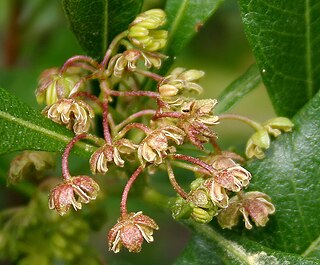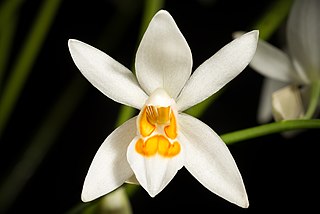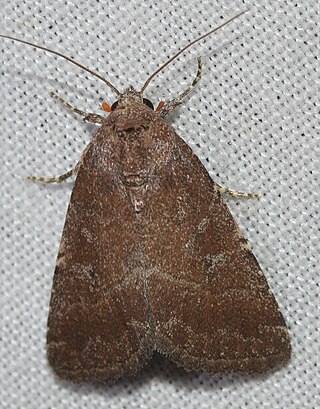
Robinia is a genus of flowering plants in the family Fabaceae, tribe Robinieae, native to North America. Commonly known as locusts, they are deciduous trees and shrubs growing 4–25 metres (13–82 ft) tall. The leaves are pinnate with 7–21 oval leaflets. The flowers are white or pink, in usually pendulous racemes. Many species have thorny shoots, and several have sticky hairs on the shoots.

Coelogyne is a genus of 594 species, which are sympodial epiphytes from the family Orchidaceae, distributed across India, China, Indonesia and the Fiji islands, with the main centers in Borneo, Sumatra and the Himalayas. They can be found from tropical lowland forests to montane rainforests. A few species grow as terrestrials or even as lithophytes in open, humid habitats. The genera BolborchisLindl., HologynePfitzer and PtychogynePfitzer are generally included here. The genus is abbreviated Coel. in trade journals.
Black orchid or Black Orchid may refer to:

Dodonaea viscosa, also known as the broadleaf hopbush, is a species of flowering plant in the Dodonaea (hopbush) genus that has a cosmopolitan distribution in tropical, subtropical and warm temperate regions of Africa, the Americas, southern Asia and Australasia. Dodonaea is part of Sapindaceae, the soapberry family.

Dodonaea, commonly known as hop-bushes, is a genus of about 70 species of flowering plants in the soapberry family, Sapindaceae. The genus has a cosmopolitan distribution in tropical, subtropical and warm temperate regions of Africa, the Americas, southern Asia and Australasia, but 59 species are endemic to Australia.

Coelogyne nitida is a species of orchid in the Coelogyne genus.

The Field Elm cultivar Ulmus minor 'Webbiana', or Webb's curly-leaf elm, distinguished by its unusual leaves that fold upwards longitudinally, was said to have been raised at Lee's Nursery, Hammersmith, London, circa 1868, and was first described in that year in The Gardener's Chronicle and The Florist and Pomologist. It was marketed by the Späth nursery of Berlin in the late 19th and early 20th centuries as U. campestris WebbianaHort., and by Louis van Houtte of Ghent as U. campestris crispa (Webbiana). Henry thought 'Webbiana' a form of Cornish Elm, adding that it "seems to be identical with the insufficiently described U. campestris var. concavaefoliaLoudon" – a view repeated by Krüssmann.
The hybrid elm Ulmus × hollandica 'Viscosa' is probably one of a number of cultivars arising from the crossing of the Wych Elm U. glabra with a variety of Field Elm U. minor. The tree was listed by Loddiges, in his catalogue of 1836 and two years later by Loudon in Arboretum et Fruticetum Britannicum 3: 1378, 1838, as U. viscosa. An early specimen in the Herbarium Dumortier named U. viscosaAudibert was later sunk by Melville as U. × hollandica.

Coelogyne barbata is a species of flowering plant in the family Orchidaceae. It is a shade-loving orchid that blooms in the months of October–November. It occurs in the Himalayas, Nepal, India, China and Myanmar. It grows epiphytic on trees or lithophyte on rocks in lower montane forests at an altitude of 1000 to 1800 meters above sea level. It is also found in Phalee but is rare. It has long, broad leaves and a bulb stem that grows from the roots. It blooms in September- November. It's a shade loving orchid.

Coelogyne cristata is an epiphytic orchid that comes from cool, moist areas of the eastern Himalayas and Vietnam. It blooms every spring, before the snow begins to melt. Its genus name Coelogyne originates from two Greek words, koilos ("hollow") and gyne ("woman"), because of the orchid's concave stigma. Cristata takes its species name from crista, the Latin word for "comb", because of the look of the flower's lip.

Coelogyne fuscescens is a species of orchid. It is found in Nepal, India, Sikkim, Bhutan, lower Myanmar, China and northeastern Thailand.

Coelogyne tomentosa is a species of Orchid.

Dittrichia viscosa, also known as false yellowhead, woody fleabane, sticky fleabane and yellow fleabane, is a flowering plant in the daisy family.

Condica viscosa is a species of moth in the family Noctuidae. It was described by Christian Friedrich Freyer in 1831. It is found from southern Europe and North Africa to Arabia and the southern parts of western Asia. The habitat consists of lowland areas near the coast, including dry slopes, road side verges, dry river beds or fallow land.

Coelogin is a phenanthrenoid found in the high altitude Himalayan orchid Coelogyne cristata. This molecule has a phenanthro[4,5-bcd]pyran structure.

Coeloginin is a phenanthrenoid found in the high altitude Himalayan orchid Coelogyne cristata. This molecule has a phenanthro[4,5-bcd]pyrone structure.

Coeloginanthrin is a phenanthrenoid found in the orchid Coelogyne cristata.

Cleome viscosa, the Asian spiderflower or tick weed is an annual herb that grows up to a meter high. It belongs to the family Cleomaceae. It is considered an invasive species and is widely distributed in warm and humid habitats across the Americas, Africa and Asia, and in Australia. It is commonly found during the rainy season.

![]() Media related to Coelogyne viscosa at Wikimedia Commons
Media related to Coelogyne viscosa at Wikimedia Commons













